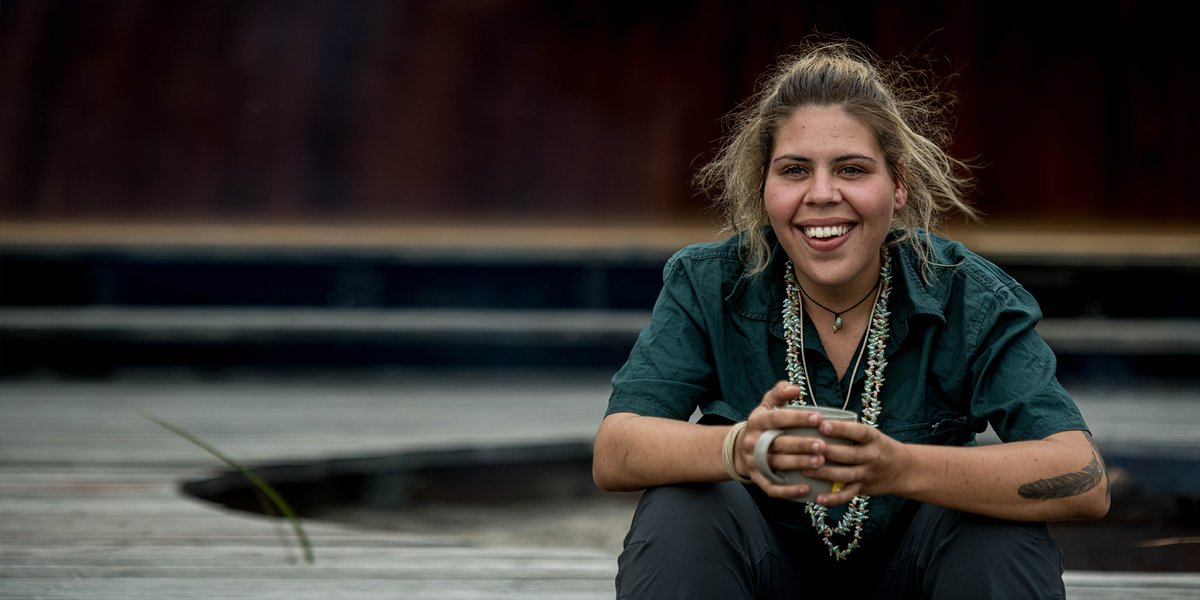Aunty Verna Nichols & Tracy Purdon Walsh
"Killiecrankie is my home, and I see the trees, the earth, the water, as part of me when I was born. I call it my heartland."
"When I wanted to use quills, Aunty Verna, she was a bit unsure. She hadn't really worked with them, so we learnt together. We had to get someone else in to help us. We cracked on for the day and got it done."
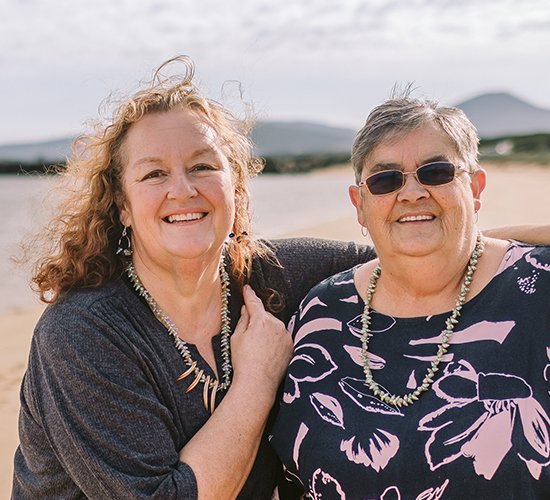
Verna:
“My cousin Lennah, she taught me how to do baskets.
"Actually she was the one who taught me most things. Everything to do with Culture. My first time doing baskets, we were out on her back patio, and I could not work it out. It just didn't gel with me. I threw it across the patio, and she'd make me go and get it. When I finished, she said, ‘Now you've done that, you won't forget it, and you'll be able to make it out of anything at all.’ Because she made me do it out of string.
And she was right. She said, ‘You have to do that with all your cultural things.’
I've been passing on my culture for that many years that I can't remember. I used to work for Catholic Education, and I spent years going into every school in southern Tasmania. It's just naturally in me now, I don't even think about it, to pass it on. It’s something within you.
Shell stringing is in our family. I was born here on Flinders, my mother, and her mother and father, they were all born on Cape Barren Island. Aunty Vida, my great aunt, she used to do shell stringing. Mum said as kids they remember her coming over; she'd have little jars and handkerchiefs with shells in them. Mum said she had really long fingers. That's all she could remember: Aunty Vida and these long fingers, taking the shells out and stringing them.
I taught Tracy about maireener shells and shell stringing. Next thing I know, she comes over and she's got echidna quills. Then she was into earrings. And see, earrings don't do anything for me, just not interested, but Tracy… that's what it's about. I think with traditional things, it's alright to follow that tradition and it's important that you do, but you can't stay static either. I think it just naturally evolves into something else.”
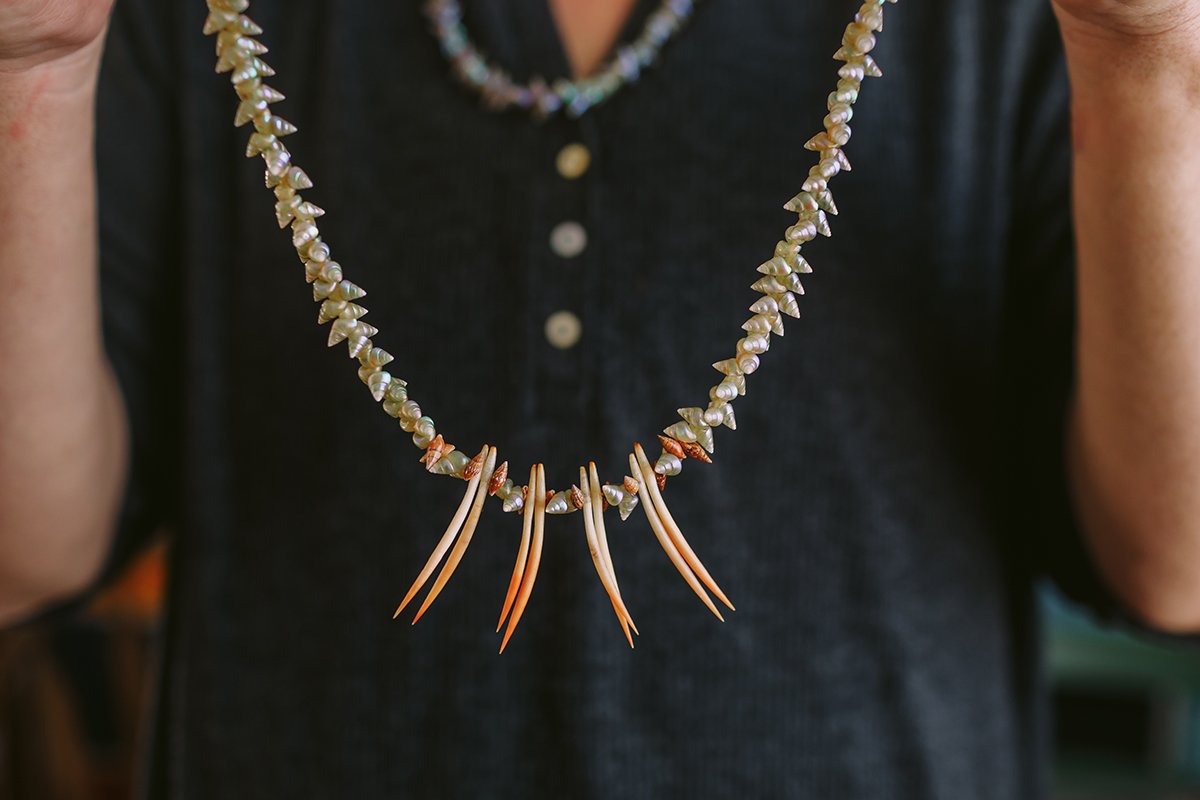
Tracy:
“It all stems from the basics. When I wanted to use quills, Aunty Verna, she was a bit unsure. She hadn't really worked with them, so we learnt together. We had to get someone else in to help us, another family member, an Aunty. She sat here, and we cracked on for the day and got it done. I put them in an exhibition, and they sold. In one way I wanted them not to sell, I wanted to keep the very first echidna necklace that I made. In other ways, I'm happy that they did.
Sometimes I'll go shelling, and come over with my bag of shells that I've got that are still wet. We'll count them out together to see how many we've got, ‘Oh, look at that one. Look at the size of that.’ Even now, if I’ve found some shells and I'm not sure where to put the holes or how to do it, then I'll be back over to Aunty Verna’s — ‘How do I do that? Does this look right?’
You learn a lot by your mistakes, and you try different things. If this didn't work, try that. Now, let's use something else and see whether that works. Some mistakes are the best ones you’ve ever made.
There are other Aunties around too. I was going shelling one day and there was another Aunty at the beach, ‘Do you know what they look like, the rice shells? Are you right with that? This is what I've got.’ She was just double-checking little things, making sure that she passed on a little bit, or making sure that I knew already. You feel connected to everybody. Everyone wants to share and make sure they get it in there, drum it into us younger ones, the next generation.”
Verna:
“People don't realise the amount of work that is in a necklace. It takes twelve months, or more, to get enough shells to make one necklace. Then you have to clean them, and you have to make sure there's no fish left in them. That could be another six months on top of that, twelve even. And it's important that you go and collect your own shells. There's no using other people's shells. It's just not on. You have to do the whole process from go to woe. You have to get your feet wet.
If I'm sitting here with no one, stringing shells or making baskets, I'm enjoying it, and it's a reasonably strong connection. I refer to it like a piece of string. I'm sitting here on my own, one strand, and yes, it's going to be strong, but you know if you pull hard enough it will break.
But if Tracy comes over, or I'm teaching the other Aboriginal women together… when we are all together, all the laughter, the talk, the teachings, everything, it's adding the other threads. If I tried to pull it, it's not going to break. That's why it's important that we pass it down. That's keeping our strength.
After I show Tracy how to do the traditional baskets and she's got it down pat, it's her journey now. Tracy has already started passing what she knows.”
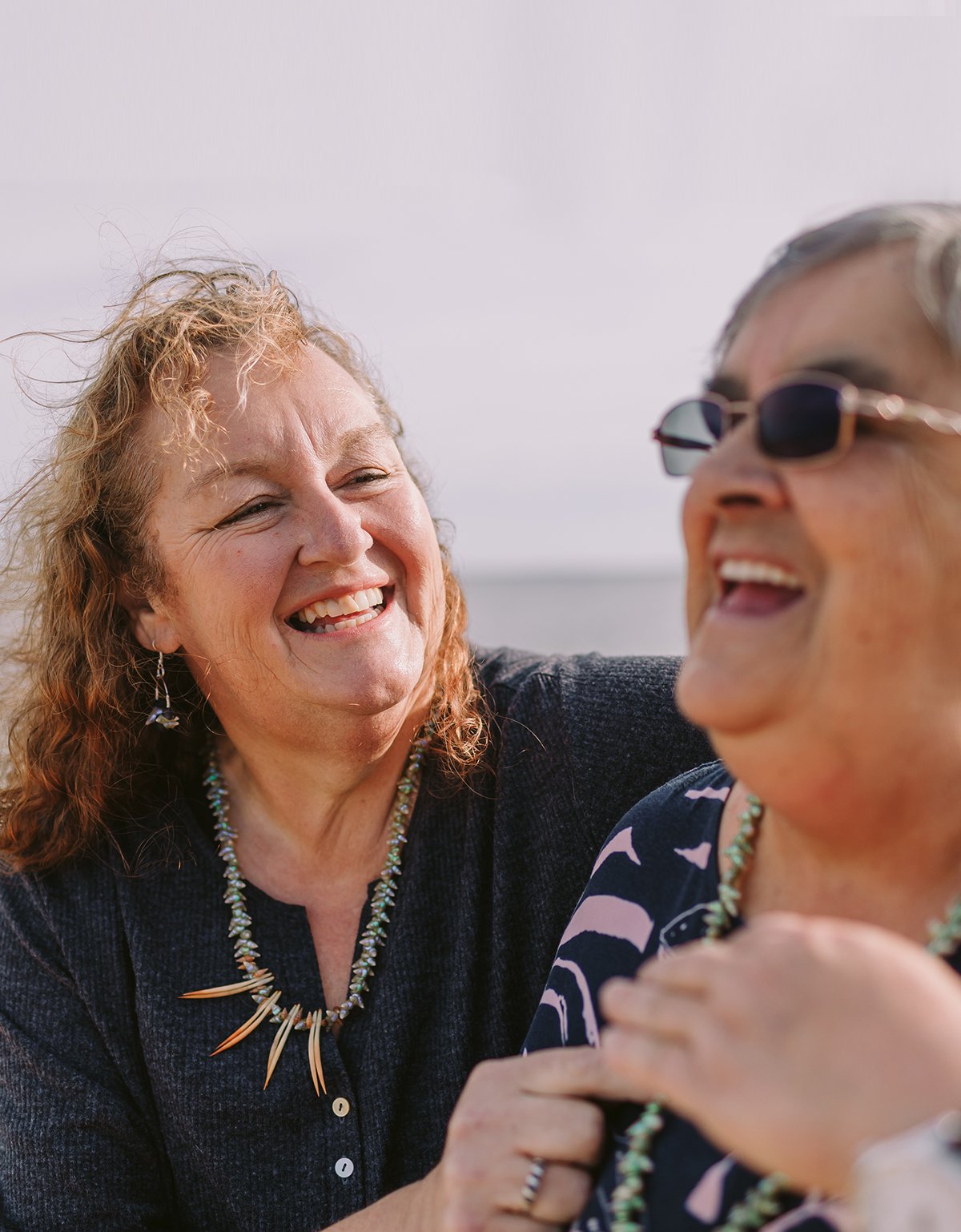
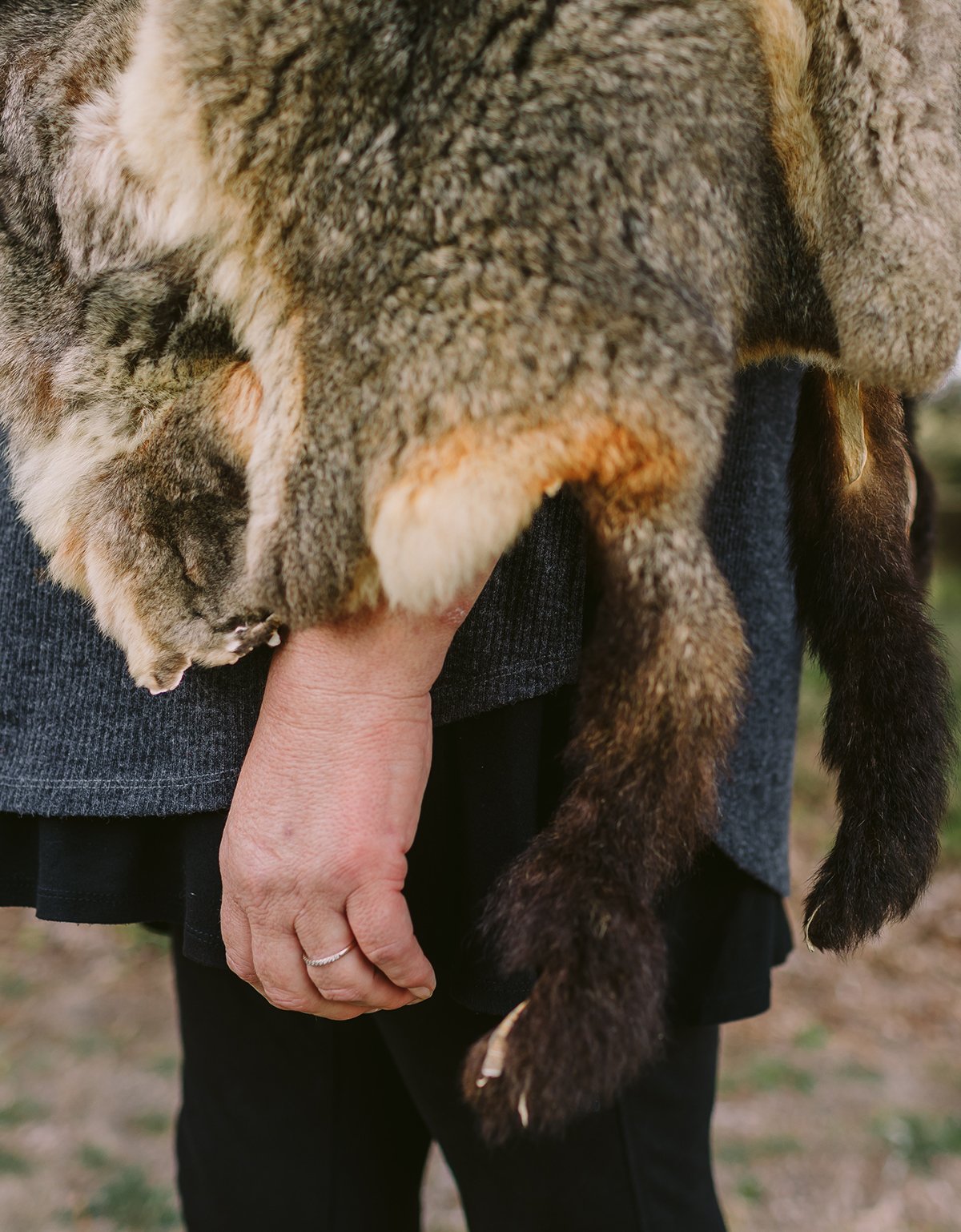
Even if you weren't family here on Flinders, as a kid, the community was always part of it.
Tracy:
“My niece, she’s nine now, we’d go to the beaches to get her interested from when she was little. ‘There's a maireener, there's a maireener,’ and I'd race her to it. ‘Oh, I'm going to put that in my bag. How many have you got?’ Now, she's just mad on it. She wants to pick them up all the time. My nephew, he's ringing me up and saying, ‘I found some shells, I found some black ones on the rocks. Do you want some black ones?’ They are getting right into it.
Even if you weren't family here on Flinders, as a kid, the community was always part of it. You were at each other’s places. Or there was always something happening at the beach; we were always going there. So, that was a big part of it, just that family connection. I moved down to Hobart for a couple of years, and then I've come back, and I've stayed here ever since. The pull was too much for me and I wanted to come home.
Driving up over that hill, seeing Killiecrankie and the mountain, that was always my, ‘I’m nearly home, I'm home soon,’ moment. I could breathe again.”
Verna:
“I think the place that you are born is special to everyone, but I feel that with us Aboriginal people, it has much more meaning. Killiecrankie is my home, and I see the trees, the earth, the water, as part of me when I was born. They were all born in me then, and they've helped shape me. I call it my heartland. It means so much more than just being born here.
I was so excited to move home. It was excitement, but peace. And when I came, I brought a nephew and two great grandsons. These little fellas, it was all new to them. They had this freedom that they didn't have in town. And that's why I say where you were born means something totally different. I think I've instilled in their parents, the importance of Flinders, just like to my mum, and then to me. Somehow it just goes in and onto the next, without us really having to sit down and explain it all. When our bare feet are standing on the earth, it's entering our body. It's entered my grandchildren, great-grandchildren as well.
They're learning their culture.
I firmly believe we didn't lose it. We lost it when the whitefellas came, but I believe that it was asleep in all of us. And then when it started to come out, well, it took a little while. But something tells you, you go this way and that way. Before you know it, you are producing the same stitch that our ancestors did. It's an awakening, a learning experience. It's our old girls up there saying, ‘You can do it.’ And when I think back about my first basket, it's someone saying, ‘Go and pick it up. Go and pick it up.’ And I'm glad that I did.”

We worked with southern Tasmanian photographers Fred + Hannah and southern Tasmanian videographer The Human Story Films for this Tasmanian story.
Read about more Tasmanians
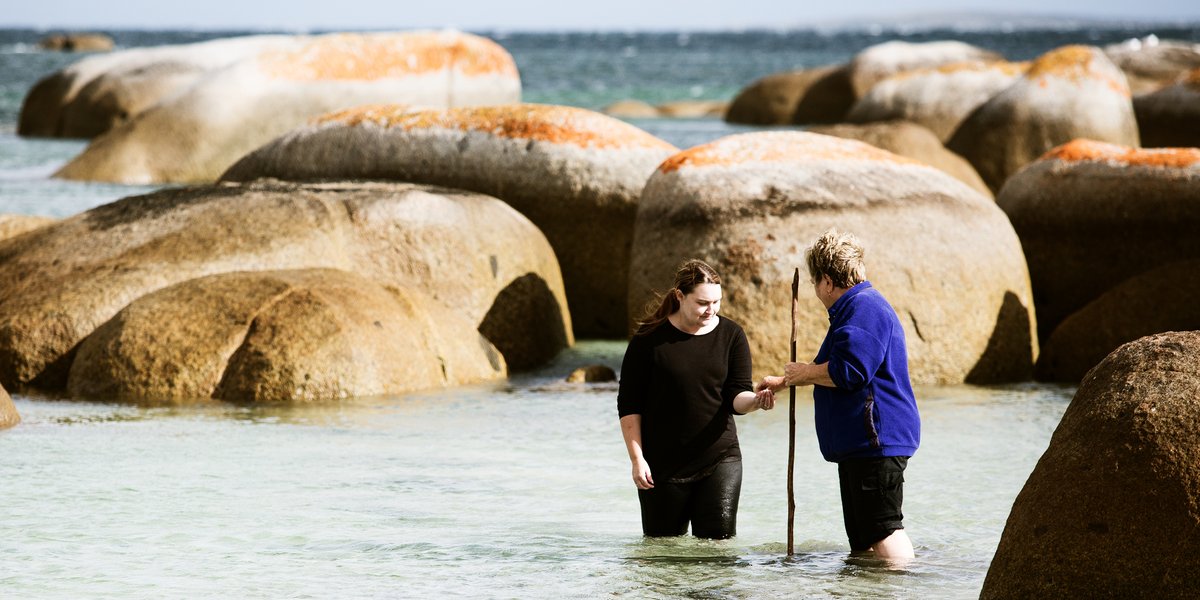
Jeanette James

Mary Knights
